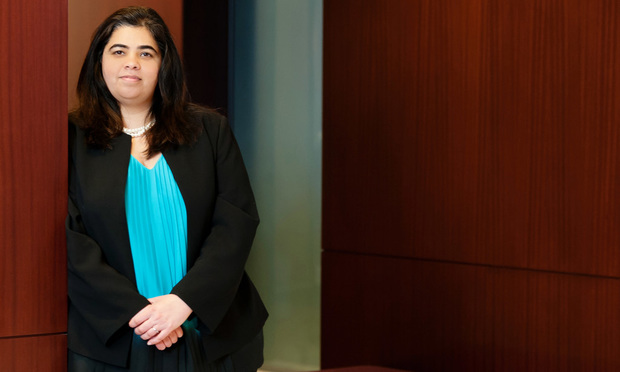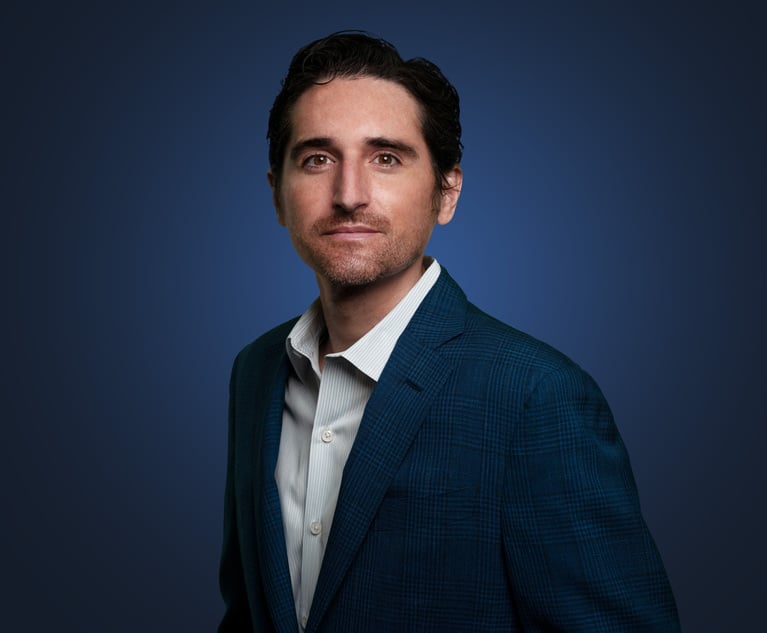Hurry Up and Wait: Indian Foreign Nationals Facing Immigration Backlogs
Immigration paths for many foreign nationals are being methodically deterred by the current administration in Washington, but citizens from India seem to have a multitude of barriers to continue living and working in the United States after completing their college education.
May 15, 2018 at 02:38 PM
6 minute read
 Karuna SImbeck of Klasko Immigration Law Partners
Karuna SImbeck of Klasko Immigration Law Partners
Immigration paths for many foreign nationals are being methodically deterred by the current administration in Washington, but citizens from India seem to have a multitude of barriers to continue living and working in the United States after completing their college education.
By way of background, foreigners wanting to pursue an education in the United States are issued F-1 visas. Upon completion of studies, the F-1 student has limited options to pursue employment in the United States. One of the most popular options available to a student on an F-1 visa, especially for those studying and working in the fields of science, technology, engineering or mathematics (STEM) is to use OPT (optional practical training) for temporary employment after graduating. This gives a student one year (up to three with extensions available to those in a STEM field) to work in the United States on a temporary basis.
Participation in the OPT program has grown exponentially in the last decade, but recent restrictions have been implemented by USCIS in limiting the experience to only in-house and on the employer's own work site, which greatly limits opportunities for consulting in business or tech. While the current administration is actively working to restrict OPT, it stays in litigation in federal court.
Once a student's OPT expires, their next step is often trying to obtain H-1B status. H1B status requires the foreign national's employer to sponsor the petition. And even then, the foreign national only has about a 25 percent chance of being selected in the lottery that is capped at 65,000 for those who hold a bachelor's degree, with an additional 20,000 available for those who have a U.S. master's degree or higher.
If a foreign national is lucky enough to be selected in the lottery, recent processing changes implemented at the beginning of 2017 have made the adjudication process much more restrictive and the likelihood of approval much more difficult. These restrictive adjudications are targeted at occupations that attract many Indian nationals, including the IT field. A specialty occupation has been redefined to exclude many IT-related jobs that may have more than one related degree. Many positions suffering this scrutiny are in the fields of data or analytics, often in emerging occupations where there are not specific degrees offered simply because the field of study is so new.
For any Indian national that currently holds a very coveted and difficult-to-obtain H-1B visa, he has no guarantee he will be able to remain in that job in the future. In the second half of 2017, USCIS eliminated prior guidance to adjudicators to give deference to petitions for an extension of an H-1B visa, meaning these petitions would get as much scrutiny as if petitioning for the first time, resulting in more RFEs which would have previously been unplanned for.
After all that, in order to plan for a permanent future in the United States, the Indian foreign national's employer would need to sponsor her for a green card through the PERM labor certification process. Then the foreign national's application would be “wait-listed” to receive a green card through the EB-2 or EB-3 quota explained below. A conservative estimate to receive a green card for an Indian national in these categories is over 12 years. While waiting those 12 or more years, the foreign national cannot leave their employer, or even get promoted, because then they would have to start the process all over again.
The Visa Office in the Department of State (DOS) allocates green cards based on a series of eligibility requirements under the provisions of U.S. immigration law, specifically the Immigration and Nationality Act (INA). Employment-based (EB) immigration is divided into five preference categories, EB-1 to EB-5. A backlog means that there is a wait list for green cards in the relevant preference category, so even where the government has approved the initial petition, the foreign national has to wait before she can apply for a green card based on that approval.
About 140,000 EB green cards become available every year and when the visa numbers in one category is expected to be issued in one fiscal year, the DOS institutes a per-country restriction for that category. This means that no country can receive more than 7 percent of visas allocated in that entire category.
Since 2005, there has been a multi-year backlog for most foreign nationals applying under the EB-3 category, and for Chinese and Indian nationals applying under the EB-2 category. Given all the hurdles Indian nationals face through the OPT and the wait list in the EB-2 and EB-3 categories, two other options often pursued by Indian nationals are EB-1 (multi-national executive/manager or alien of extraordinary ability) and EB-5 (investment of $1,000,000 or $500,000.
With more Indian nationals relying on these two categories, it's no surprise that a visa cut-off date of January 2012 was established for EB-1 India in April 2018, and a backlog is predicted for EB-5 India around June 2019. Possibly the worst effect is on the Indian national's children, who if born outside the United States will be forced to leave the country when they are too old to be included in as derivatives of their parent's applications. The rules regarding a child aging out are hyper-technical and will not be covered in this article.
The road to green cards is paved with challenges and delays; It could take decades for an Indian national to receive her green card. Most Indian nationals only start considering their long-term immigration options after they have graduated from school or when their OPT is about to expire. Given the quota backlogs, Indian nationals should start the process much earlier than they would have in the past, weigh all available options, and map out a plan for their future in the United States.
Karuna Simbeck is an associate in Klasko Immigration Law Partner's Philadelphia office and a member of the firm's EB-5 practice. As part of the EB-5 team, she is involved in various stages of the EB-5 process, including the preparation and filing of I-526 petitions for both regional center investors and individual investment opportunities.
This content has been archived. It is available through our partners, LexisNexis® and Bloomberg Law.
To view this content, please continue to their sites.
Not a Lexis Subscriber?
Subscribe Now
Not a Bloomberg Law Subscriber?
Subscribe Now
NOT FOR REPRINT
© 2025 ALM Global, LLC, All Rights Reserved. Request academic re-use from www.copyright.com. All other uses, submit a request to [email protected]. For more information visit Asset & Logo Licensing.
You Might Like
View All
AI and Social Media Fakes: Are You Protecting Your Brand?

Neighboring States Have Either Passed or Proposed Climate Superfund Laws—Is Pennsylvania Next?
7 minute read
Seven Rules of the Road for Managing Referrals To/From Other Attorneys, Part 2
6 minute readTrending Stories
- 1We the People?
- 2New York-Based Skadden Team Joins White & Case Group in Mexico City for Citigroup Demerger
- 3No Two Wildfires Alike: Lawyers Take Different Legal Strategies in California
- 4Poop-Themed Dog Toy OK as Parody, but Still Tarnished Jack Daniel’s Brand, Court Says
- 5Meet the New President of NY's Association of Trial Court Jurists
Who Got The Work
J. Brugh Lower of Gibbons has entered an appearance for industrial equipment supplier Devco Corporation in a pending trademark infringement lawsuit. The suit, accusing the defendant of selling knock-off Graco products, was filed Dec. 18 in New Jersey District Court by Rivkin Radler on behalf of Graco Inc. and Graco Minnesota. The case, assigned to U.S. District Judge Zahid N. Quraishi, is 3:24-cv-11294, Graco Inc. et al v. Devco Corporation.
Who Got The Work
Rebecca Maller-Stein and Kent A. Yalowitz of Arnold & Porter Kaye Scholer have entered their appearances for Hanaco Venture Capital and its executives, Lior Prosor and David Frankel, in a pending securities lawsuit. The action, filed on Dec. 24 in New York Southern District Court by Zell, Aron & Co. on behalf of Goldeneye Advisors, accuses the defendants of negligently and fraudulently managing the plaintiff's $1 million investment. The case, assigned to U.S. District Judge Vernon S. Broderick, is 1:24-cv-09918, Goldeneye Advisors, LLC v. Hanaco Venture Capital, Ltd. et al.
Who Got The Work
Attorneys from A&O Shearman has stepped in as defense counsel for Toronto-Dominion Bank and other defendants in a pending securities class action. The suit, filed Dec. 11 in New York Southern District Court by Bleichmar Fonti & Auld, accuses the defendants of concealing the bank's 'pervasive' deficiencies in regards to its compliance with the Bank Secrecy Act and the quality of its anti-money laundering controls. The case, assigned to U.S. District Judge Arun Subramanian, is 1:24-cv-09445, Gonzalez v. The Toronto-Dominion Bank et al.
Who Got The Work
Crown Castle International, a Pennsylvania company providing shared communications infrastructure, has turned to Luke D. Wolf of Gordon Rees Scully Mansukhani to fend off a pending breach-of-contract lawsuit. The court action, filed Nov. 25 in Michigan Eastern District Court by Hooper Hathaway PC on behalf of The Town Residences LLC, accuses Crown Castle of failing to transfer approximately $30,000 in utility payments from T-Mobile in breach of a roof-top lease and assignment agreement. The case, assigned to U.S. District Judge Susan K. Declercq, is 2:24-cv-13131, The Town Residences LLC v. T-Mobile US, Inc. et al.
Who Got The Work
Wilfred P. Coronato and Daniel M. Schwartz of McCarter & English have stepped in as defense counsel to Electrolux Home Products Inc. in a pending product liability lawsuit. The court action, filed Nov. 26 in New York Eastern District Court by Poulos Lopiccolo PC and Nagel Rice LLP on behalf of David Stern, alleges that the defendant's refrigerators’ drawers and shelving repeatedly break and fall apart within months after purchase. The case, assigned to U.S. District Judge Joan M. Azrack, is 2:24-cv-08204, Stern v. Electrolux Home Products, Inc.
Featured Firms
Law Offices of Gary Martin Hays & Associates, P.C.
(470) 294-1674
Law Offices of Mark E. Salomone
(857) 444-6468
Smith & Hassler
(713) 739-1250






